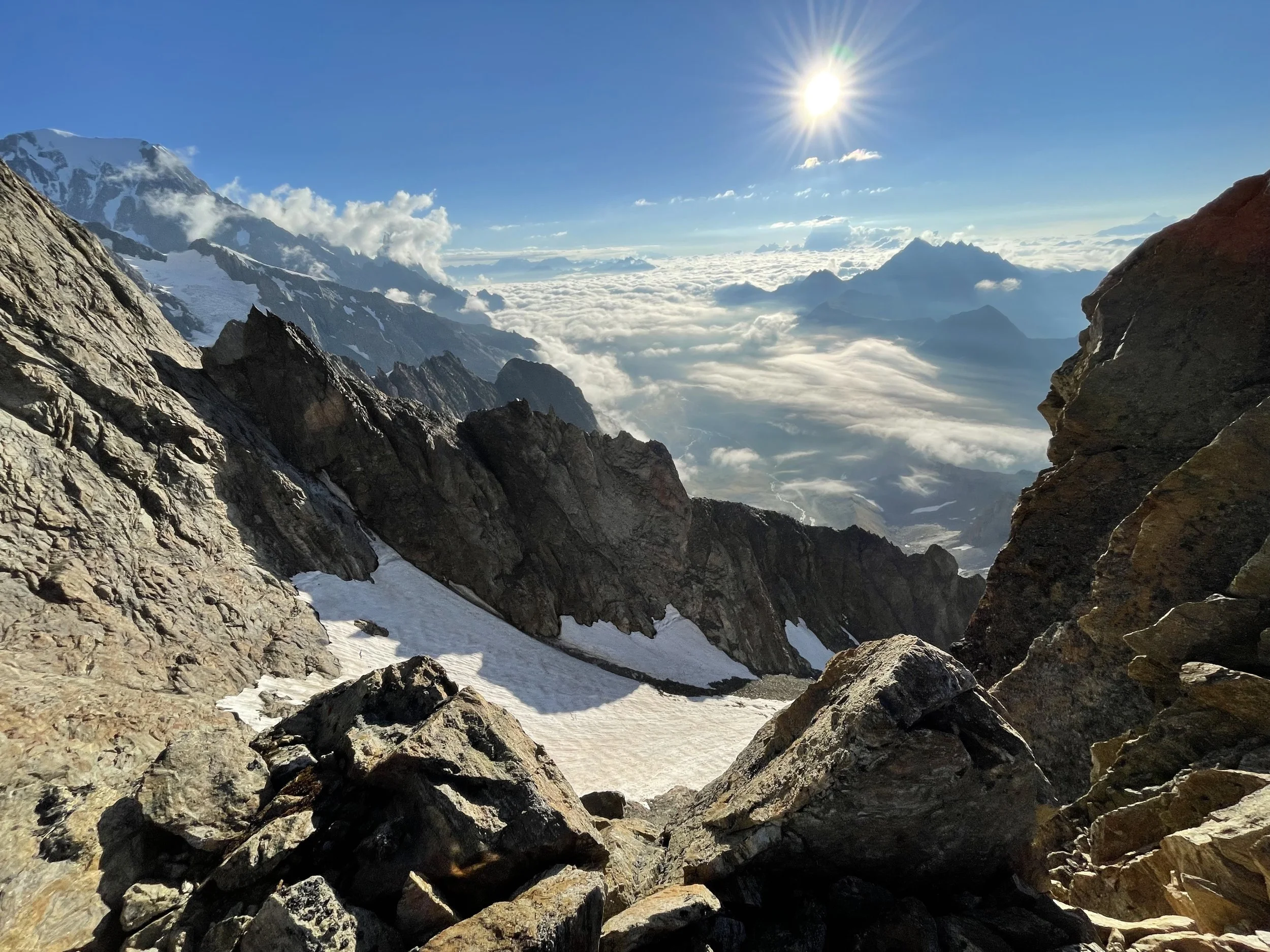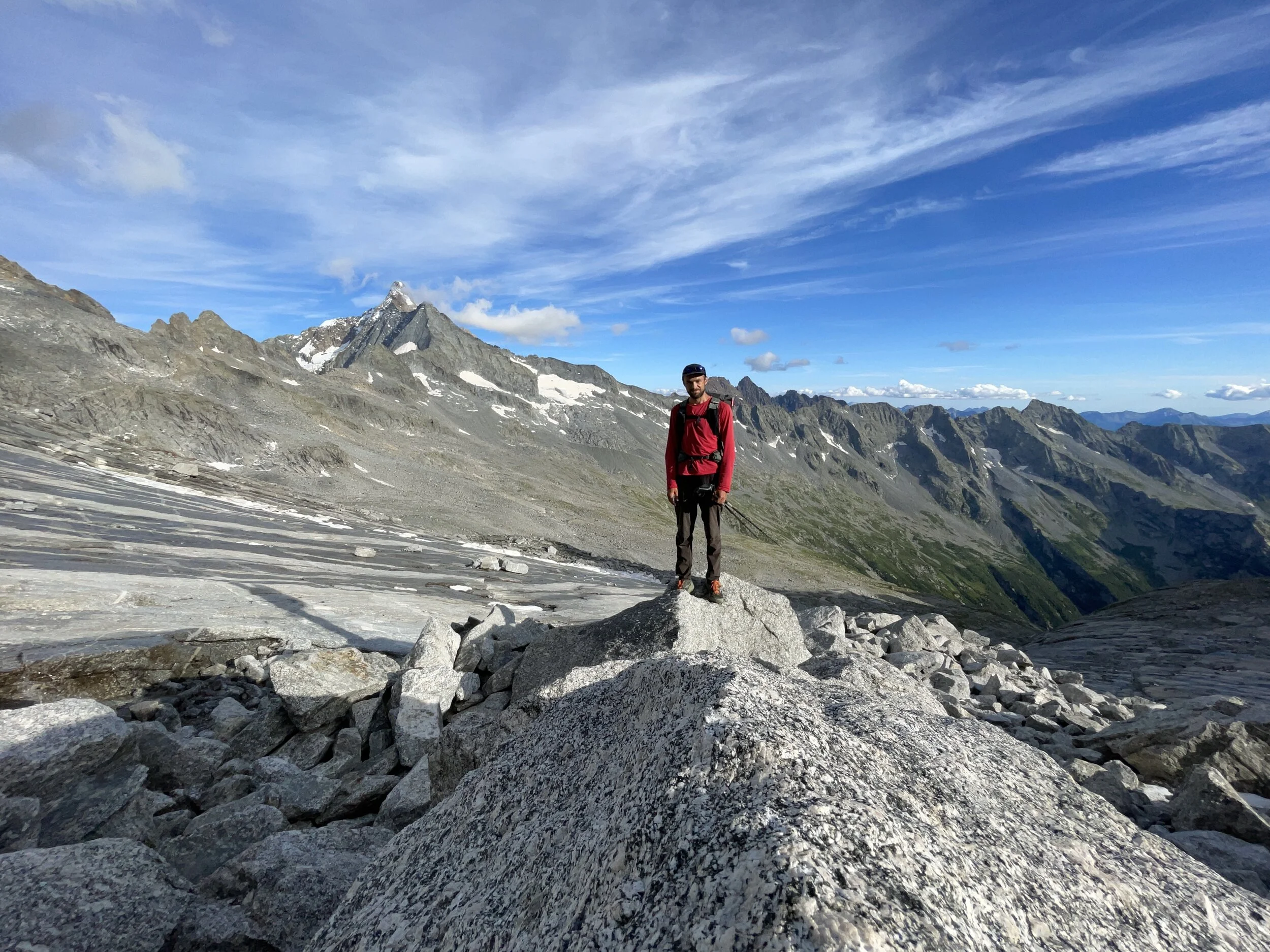
Alpine Conversation
Combining backpacking and mountaineering, I found my flow during a 1900-kilometre, 61-day crossing of the entire alps.
The Route
In 61 days, I covered roughly 1900 kilometres and over 125,000 metres of ascent from Slovenia to Monaco. Along the way, I climbed around 65 extra peaks graded up to AD-. My route was inspired by my friend John Fleetwood - an experienced fell runner and mountaineer, who crossed the Alps in 2015.
My journey covered the following regions: the Julian Alps, the Carnic Alps, the Dolomites, South Tyrol, Bregaglia, Ticino, the Pennine Alps, Aosta Valley, the Vanoise, Queyras and the Mercantour. The climbing took in many peaks between 2500 and 3900 metres, graded up to AD- and VF3.
I carried a lightweight tent, crampons, ice axe and via ferrata set….and not much else! My rucksack weighed 7.2kg without food, water and stove fuel. I passed a village store every 3-5 days to restock on food, but also ate at many refuges en route.
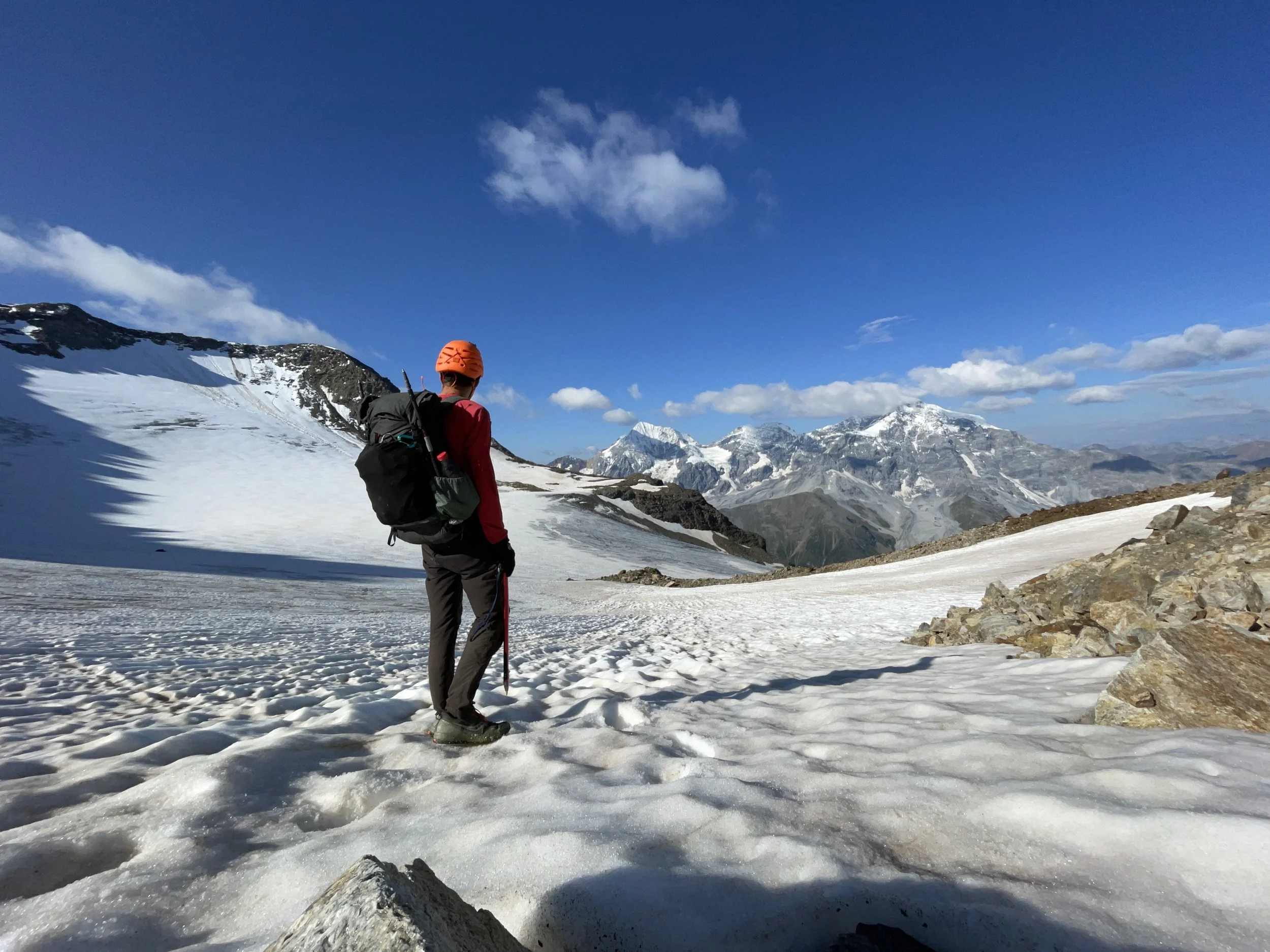
The following article first appeared in TGO Magazine.
It was day 22 of my journey across the Alps, and I'd covered almost 700km to reach South Tyrol. At dawn, I'd watched the beams of climbers head torches silently edging their way towards the summit of the Ortler. Now, I was following part of the same route.
I hoped to traverse beneath the white meringues of glacier to continue westwards. I was soon moving through a vast crumbling moraine. The path gave way to shale and boulders. There was nothing solid in amongst the braided maze of glacial outflows pouring from the surrounding cliffs. I balanced the tips of my walking poles delicately against rock edges as my feet danced on the crumbling slopes. Half walking and half scrambling, I manoeuvred around massive boulders and smeared over slabs scoured by eons of glaciation. It felt expressive, as if my body was in conversation with the landscape. Searching for the best line across the steep gullies and exposed scree slopes, I was attentive for clues in the terrain. Spotting the tracks of a chamois in front of me put me at ease. I felt less alone and validated by an expert!
So much of my journey was on ground like this. I found myself thriving on the deep concentration and physicality that it required. Time fell away and I felt connected to my surroundings, as intimidating as they often became.
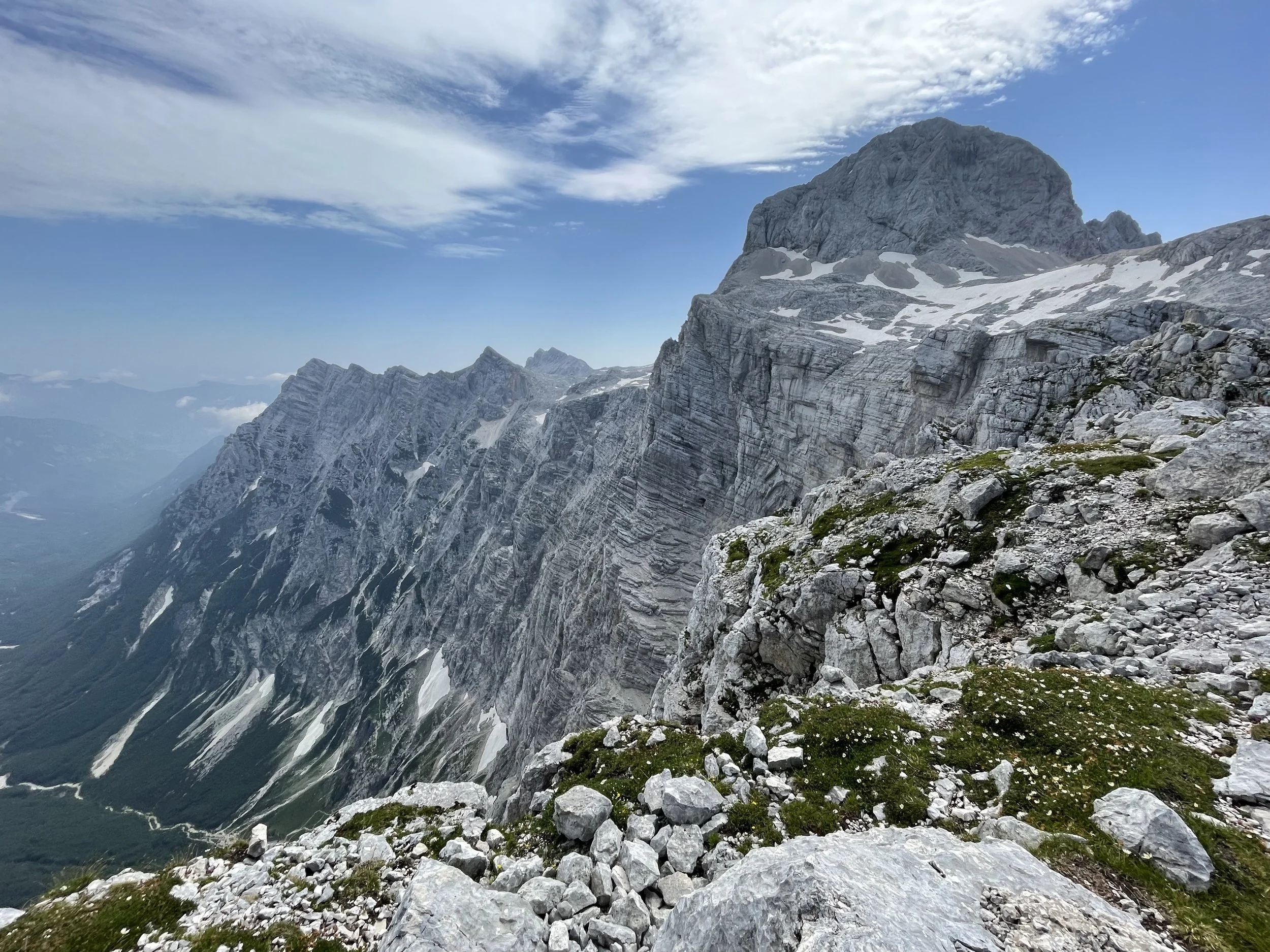
Above: The north face of Triglav in Slovenia’s Julian Alps.
Alpine Start
My attempt to traverse the Alps in their entirety began in Triglav National Park in Slovenia. Over two months in the summer of 2021, I covered over 1900km and 125,000m of ascent to reach the Mediterranean Sea. It was a mixture of backpacking, scrambling and running with mountaineering and via ferrata along the way, including ascents of Monte Disgrazia, Monviso and Basodino.
I made this journey for the same reason that I'll go out for a run, or a wander around my local nature reserve. It's to find those moments where I ‘become' the next footstep, and the ground that it connects with. In these moments I feel completely alive, and the whole world feels alive with me.
Psychologist Mihaly Csikszentmihalyi first coined the phrase flow state, saying:
"The best moments in our lives are not the passive, receptive, relaxing times... The best moments usually occur if a person's body or mind is stretched to its limits in a voluntary effort to accomplish something difficult and worthwhile".
Flow states occur when are absolutely focused and present in a task. Many people experience them whilst playing sport or performing music; but for me, it's being outdoors.
With the weather and the terrain dictating the rhythm of my days, I become totally immersed and entwined in the landscape.
Recently, I've grown more appreciative of just how much value it brings to the rest of my life as well.
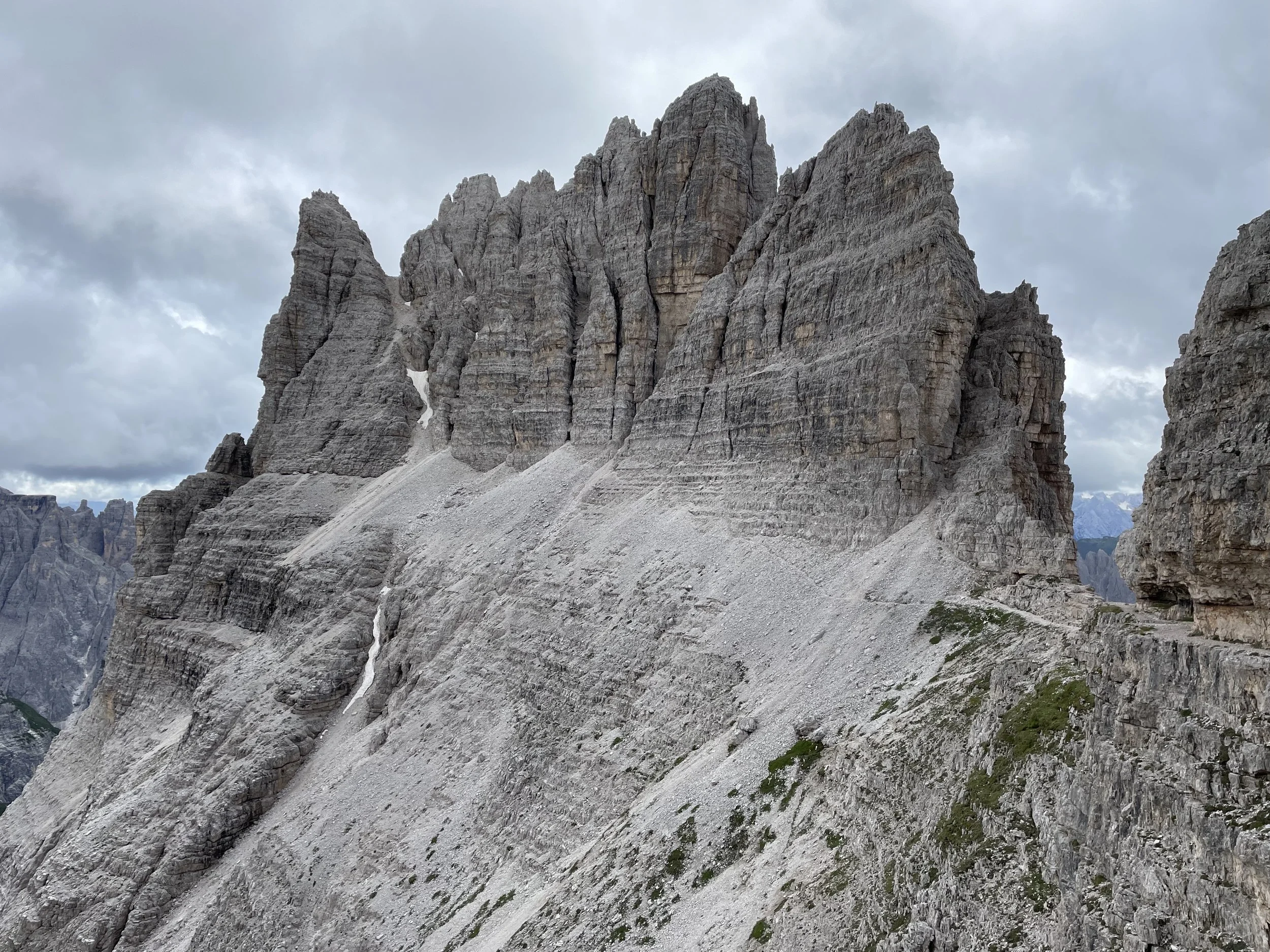
Above: limestone formations in the Dolomites, Italy.
Mind how you go
After the first four days in Slovenia, I was riding a wave of momentum that had already carried me across the Triglav National Park and into Austria. Id been climbing via ferratas and hiking for 12 hours each day, averaging well over 2000m of ascent.
However, maintaining a constant state of flow just wasn't possible. The fatigue and fading endorphins caught up with me. My knees seized, my eyelids grew heavy and my decision making was affected. On day 9 in the Carnic Alps, I climbed a high pass during a gap between thunderstorms. The ascent funnelled me into a narrowing gully of chest-high vegetation. The path on my map had long disappeared under gouged carth and old avalanche debris, but I foolishly chose to carry on, clawing my way upwards beneath darkening clouds.
As I emerged at the pass, thunder echoed around the ridges. I forced myself to peer over the edge. It was desperate. Exposed, grassy slopes and crumbling gullies plunged down towards the distant forest. A faded red and white way-marker on the rock beside me was the first I'd seen for hours. It felt like a cruel joke.
The rain began and lightning cracked nearby. I gave up on any sign of a trail and began to edge down the slope, attempting to arrest a bum-slide with my shortened poles. I reached a narrow ravine and climbed in. Hail lashed at the ground around me and the thunder became deafening. I hoped the ravine would lead to the tree line without cliffing out.
Soaked to the skin, I clung to slimy rocks and saplings, lowering myself over drops. Progress was painstaking, but the adrenaline dissolved any fatigue. The rest of the world fell away - I was absolutely focused on the next decision.
That 800m descent was the closest I felt to being in real trouble. When the forest finally sput me out at the bottom of the valley, I looked back at what i'd just come down. It seemed impossible. It had been an immersive experience, but not an enjoyable one, and luck had played far too big a role in my staying safe. I came away from it with a much healthier respect for the weather, and a better understanding of the relationship between adrenaline and control.
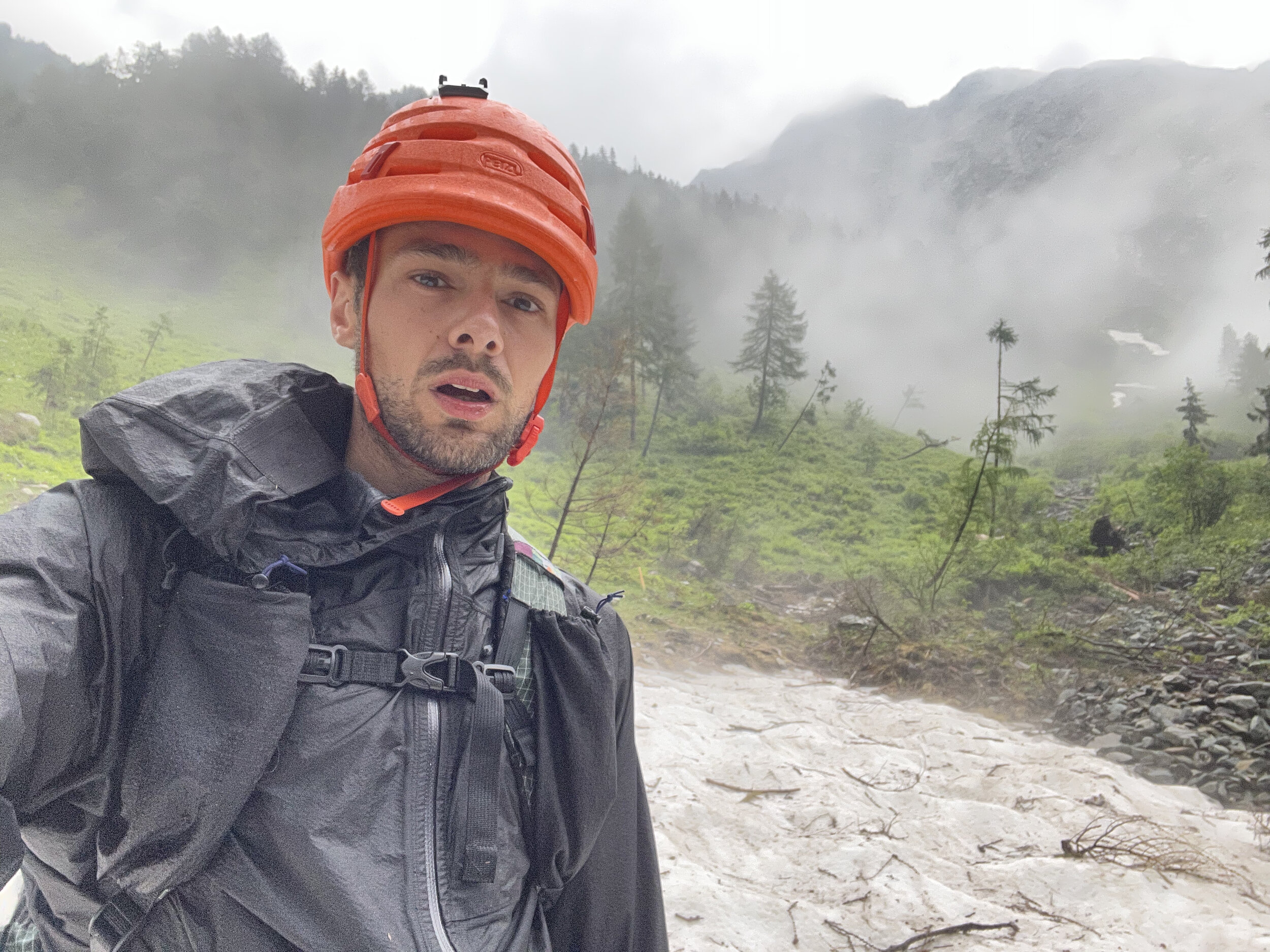
That 800m descent was the closest I felt to being in real trouble. When the forest finally sput me out at the bottom of the valley, I looked back at what I'd just come down. It seemed impossible.
Finding the flow
After 28 days, I was almost halfway along the spine of the Alps. I'd just crossed the rugged Val Masino in Italy by racking up a big, 16-hour day. Most of this was along the 'Sentiero Di Roma' - a 55km high traverse through boulder fields, slabs, and high passes laced with via ferrata chains.
This was one of my favourite parts of my journey. The terrain was never too casy, and never too hard. I was so absorbed in cach footstep and handhold, I felt completely in the moment. The crux of this section was via a steep glacier and onto the wildly exposed ridges of Monte Disgrazia. Having gained the summit ridge, the wind raged as I searched out holds with gloved hands. An exposed and splintered crest of granite was interrupted by a thin, snowy couloir at its crux. It plummeted off into open space above a distant chaos of crevasses and shattered rock.
Yet, when I looked at the snow-crusted ledges ahead, I could already feel the moves in my body. I found myself climbing with a calm assuredness. Kicking my crampons into rock and ice, I delicately picked my way down towards the edge of the couloir. I bridged my arms across the gap, and carefully inspected the holds on the other side. Once content it was safe, I committed my weight through my hands and pulled myself over the void.
The rest of the ridge just seemed to flow through me. There was a stillness in the movement, and a feeling of connection with the terrain. When I topped out beside the metal summit post of Monte Disgrazia, the Val Masino Alps stared right back at me. Looking over those endless rows of jagged peaks, I couldn't believe how far I’d travelled in just 27 days.

Above: summit ridge of Monte Disgrazia.
Time out of mind
By mid-September, I was well into the final part of my journey. I'd crossed Ticino in Switzerland on quiet paths, followed by the well-worn trails of the Tour De Monte Rosa. After that I'd continued through the Aosta Valley and into the French Vanoise. Now, the Maritime Alps were leading me south towards the sea, and into autumn.
Living in and moving through the mountains for almost two months brought with it that slow-burn immersion that only backpacking can provide. I felt I could read the terrain instinctively and feel subtle shifts in the weather. I found myself slowing down, wanting to drink it all in. The excitable energy of my beginnings in Slovenia gave way to a wholehearted contentment. My attention shifted from the grand mountain scenes on the horizon to the smaller landscapes all around me. I began to find clouds endlessly fascinating: how they were shaped by the mountains, and how they'd rise from the valleys after dawn. It was a new world I’d barely noticed before.
As l entered the steep larch forests of the Maritime Alps, I felt a wave of calm move over me. Rain dripped lazily from the branches and the sweet, earthy smells rising from the ground encouraged me to slow down instead of speed up. Why rush? Everything I turned to reached back out to me. In particular, one small branch beside the trail. Clusters of needles emerged from its thin stem, each appearing like a tiny tree in itself, and each holding a glistening bead of rainwater. It was one of the most beautiful things i'd ever seen.
Looking out to the opposite side of the valley, I watched wisps of cloud drifting over scree slopes and caught in the treetops. I felt at home in the world, and at home in myself.
Higher up, the gradient eased, and the trees fell away. The path led between broken cliff bands and scree. I sensed company and softened my steps. Moments later, a fox darted across the slopes above me. The ground at my feet was alive with a mosaic of mosses and grasses, and the leaves of the blueberry bushes were turning red. Two months before, they had been green and ripening. Like them, I felt changed by the long-term effects of the weather and time. There was a new depth to my 'flow' here. I was equally hyperattentive and completely relaxed.
It reminded me of much smaller rambles closer to home, around the Leicestershire woodlands that are very familiar to me. Getting to know somewhere properly takes time, I thought. Then, the world opens up, and the little details become everything.
After two months, it was hard to meet the sea and the end of the journey, but I feel l've brought the most important things home with me. At least for now, I can key back into those feelings of flow and connectedness that l've learnt to value so much.

Above: bivvy in Pennine Alps, Italy.
Below: mountaineering in the Mont Blanc massif.
